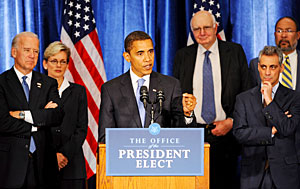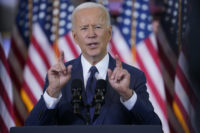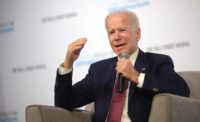On December 6, President-elect Barack Obama revealed key elements of his sweeping economic-recovery plan, part of which calls for building roads, greening federal offices, and making schools more high-tech, all of which should bode well for those in the design and construction industries.

“This has to be great news for architects,” says Robert Dunphy, who studies infrastructure issues for the Urban Land Institute, based in Washington, D.C. Advocates have made the case for years that the government needs to invest in infrastructure, he says, “but it was always easy to put off to a future date.”
Some are concerned that Congressional squabbling could delay rollout of a soup-to-nuts building plan, which analysts say could reach $500 billion. But many aren’t waiting until Obama’s January 20 inauguration to make a case for their projects. Chief among them are highway advocates, who calculate that there are 5,000 projects worth a total of $64 billion—from erecting bridges to filling pot holes—ready to launch within six months.
These public projects could put a sizable dent in the construction industry’s 10.8 percent unemployment rate, says Tony Dorsey, a spokesman for the American Association of State Highway and Transportation Officials, an advocacy group. “We are very hopeful that in the near future we will see spending on transportation projects that could create 1.8 million jobs,” Dorsey says.
Schools will also be targeted by Obama’s infrastructure campaign, which already has mayors and governors vying for slices of the pie. In December, the National Governors Association unveiled a request for $136 billion, part of which would go toward fixing up classrooms; the U.S. Conference of Mayors also recently debuted a $73.2 billion plan with similar aims.
Barbara Nadel, FAIA, a New York architect who has represented the AIA on Capitol Hill for years, says she suspects school construction will be a significant portion of Obama’s spending plan because it “touches every community in America.” Nadel is also hopeful that veterans’ hospitals and embassies will be rebuilt or renovated.
In his December address, Obama said “our government now pays the highest energy bills in the world. We need to change that.” Creating more-efficient heating and cooling systems in federal offices, plus adding more daylight and cleaner air, is embraced by Rick Cook, FAIA, a partner at Cook + Fox, a New York City firm that’s been active for more than a decade in the “green” building movement. “The real pay dirt is in human productivity and health, which is slightly hard to quantify,” Cook says. “But I think it’s absolutely mandatory the new administration take a leadership role in creating of green-collar jobs.”
So far, investors seem to like what they’re hearing. In early December, stocks had risen for several construction-related companies, including Caterpillar, which makes heavy equipment, and Fluor, which offers engineering services. Granite Construction, which builds airports and tunnels, saw its stock climb to $49.09 on December 8, up from $35.85 in September.
Still, for architects, it may take time for any stimulus to generate commissions and paychecks. “I am heartened by Obama’s plans,” says Bradford Perkins, FAIA, chairman of Perkins Eastman, one of the country’s largest firms. “I just can’t imagine any government program will immediately make things look any better than they do now, which is not very good.”
Read our related story: “AIA Outlines Goals for New President.”





Post a comment to this article
Report Abusive Comment